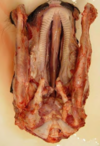Alimentary 1 Pics Flashcards
What type of plant is this?
What 2 conditions can it cause?

- Veratrum californicum
- Cleft palate and cleft lip
What is this condition called?

Cleft palate
What is this condition called?
What are two other names for it?

- Cheiloschisis
- Hare lip and cleft lip
What is this condition called?

Brachygnathia (shorter lower jaw)
What is this condition called?

Prognathia (protrusion of the lower jaw)
Loss of tooth structure caused by mastication is known as what?
Abnormal wearing can result in what condition?

- Dental attrition
- Step mouth
This is an extreme example of what?

Periodontal disease
What is this condition called?
Which bacteria is it caused by?

- Actinobacillosis (Wooden Tongue)
- Actinobacillus lignieresii
What gram-negative rod-shaped bacteria is represented in this slide?
The radiating clubs of amorphous eosinophilic material seen in the center of this slide are known as what?

- Actinobacillus lignieresii
- Splendore-Hoeppli phenomenum
What is this condition called?
Which diploid fungus is the causative agent?

- Thrush (Candidiasis)
- Candida albicans
What are these called?

Lingual lesions
What is this condition called?

Lymphoplasmacytic gingivitis
What is this condition called?

Feline chronic gingivo-stomatitis
What is the name of this condition common in older dogs?

Chronic ulcerative (lympho-plasmacytic) paradental stomatitis
What is the name of this condition?

Viral vesicular stomatitides




















